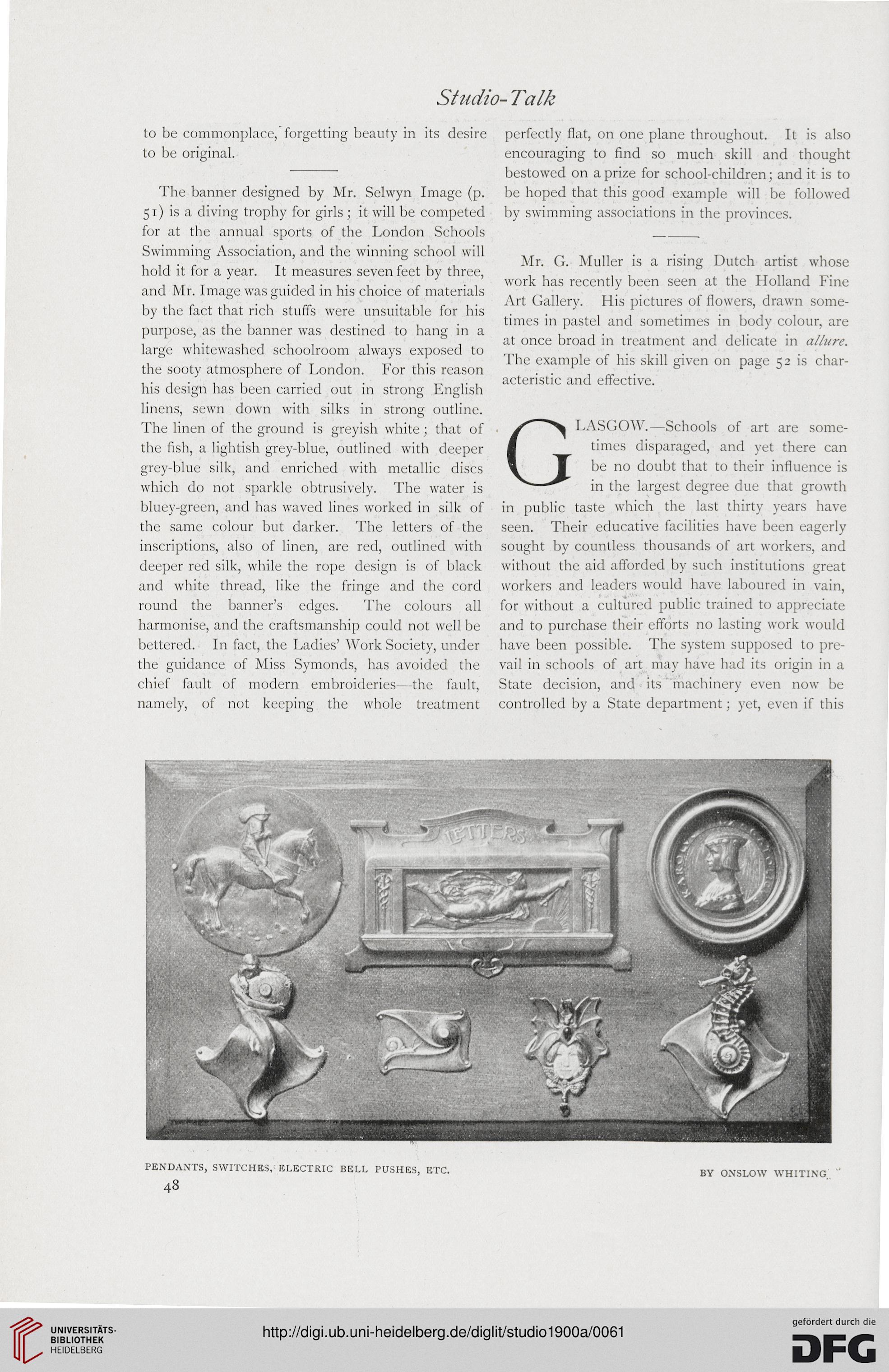Studio- Talk
to be commonplace, forgetting beauty in its desire
to be original.
The banner designed by Mr. Selwyn Image (p.
51) is a diving trophy for girls ; it will be competed
for at the annual sports of the London Schools
Swimming Association, and the winning school will
hold it for a year. It measures seven feet by three,
and Mr. Image was guided in his choice of materials
by the fact that rich stuffs were unsuitable for his
purpose, as the banner was destined to hang in a
large whitewashed schoolroom always exposed to
the sooty atmosphere of London. For this reason
his design has been carried out in strong English
linens, sewn down with silks in strong outline.
The linen of the ground is greyish white ; that of
the fish, a lightish grey-blue, outlined with deeper
grey-blue silk, and enriched with metallic discs
which do not sparkle obtrusively. The water is
bluey-green, and has waved lines worked in silk of
the same colour but darker. The letters of the
inscriptions, also of linen, are red, outlined with
deeper red silk, while the rope design is of black
and white thread, like the fringe and the cord
round the banner's edges. The colours all
harmonise, and the craftsmanship could not well be
bettered. In fact, the Ladies' Work Society, under
the guidance of Miss Symonds, has avoided the
chief fault of modern embroideries—the fault,
namely, of not keeping the whole treatment
perfectly flat, on one plane throughout. It is also
encouraging to find so much skill and thought
bestowed on a prize for school-children; and it is to
be hoped that this good example will be followed
by swimming associations in the provinces.
Mr. G. Muller is a rising Dutch artist whose
work has recently been seen at the Holland Fine
Art Gallery. His pictures of flowers, drawn some-
times in pastel and sometimes in body colour, are
at once broad in treatment and delicate in allure.
The example of his skill given on page 52 is char-
acteristic and effective.
GLASGOW.—Schools of art are some-
times disparaged, and yet there can
be no doubt that to their influence is
in the largest degree due that growth
in public taste which the last thirty years have
seen. Their educative facilities have been eagerly
sought by countless thousands of art workers, and
without the aid afforded by such institutions great
workers and leaders would have laboured in vain,
for without a cultured public trained to appreciate
and to purchase their efforts no lasting work would
have been possible. The system supposed to pre-
vail in schools of art may have had its origin in a
State decision, and its machinery even now be
controlled by a State department; yet, even if this
PENDANTS, SWITCHES, ELECTRIC BELL PUSHES, ETC.
48
BY ONSLOW WHITING
to be commonplace, forgetting beauty in its desire
to be original.
The banner designed by Mr. Selwyn Image (p.
51) is a diving trophy for girls ; it will be competed
for at the annual sports of the London Schools
Swimming Association, and the winning school will
hold it for a year. It measures seven feet by three,
and Mr. Image was guided in his choice of materials
by the fact that rich stuffs were unsuitable for his
purpose, as the banner was destined to hang in a
large whitewashed schoolroom always exposed to
the sooty atmosphere of London. For this reason
his design has been carried out in strong English
linens, sewn down with silks in strong outline.
The linen of the ground is greyish white ; that of
the fish, a lightish grey-blue, outlined with deeper
grey-blue silk, and enriched with metallic discs
which do not sparkle obtrusively. The water is
bluey-green, and has waved lines worked in silk of
the same colour but darker. The letters of the
inscriptions, also of linen, are red, outlined with
deeper red silk, while the rope design is of black
and white thread, like the fringe and the cord
round the banner's edges. The colours all
harmonise, and the craftsmanship could not well be
bettered. In fact, the Ladies' Work Society, under
the guidance of Miss Symonds, has avoided the
chief fault of modern embroideries—the fault,
namely, of not keeping the whole treatment
perfectly flat, on one plane throughout. It is also
encouraging to find so much skill and thought
bestowed on a prize for school-children; and it is to
be hoped that this good example will be followed
by swimming associations in the provinces.
Mr. G. Muller is a rising Dutch artist whose
work has recently been seen at the Holland Fine
Art Gallery. His pictures of flowers, drawn some-
times in pastel and sometimes in body colour, are
at once broad in treatment and delicate in allure.
The example of his skill given on page 52 is char-
acteristic and effective.
GLASGOW.—Schools of art are some-
times disparaged, and yet there can
be no doubt that to their influence is
in the largest degree due that growth
in public taste which the last thirty years have
seen. Their educative facilities have been eagerly
sought by countless thousands of art workers, and
without the aid afforded by such institutions great
workers and leaders would have laboured in vain,
for without a cultured public trained to appreciate
and to purchase their efforts no lasting work would
have been possible. The system supposed to pre-
vail in schools of art may have had its origin in a
State decision, and its machinery even now be
controlled by a State department; yet, even if this
PENDANTS, SWITCHES, ELECTRIC BELL PUSHES, ETC.
48
BY ONSLOW WHITING




